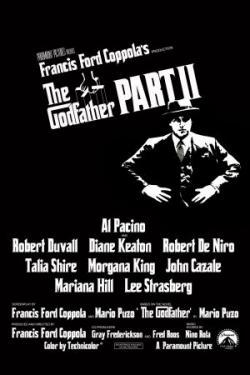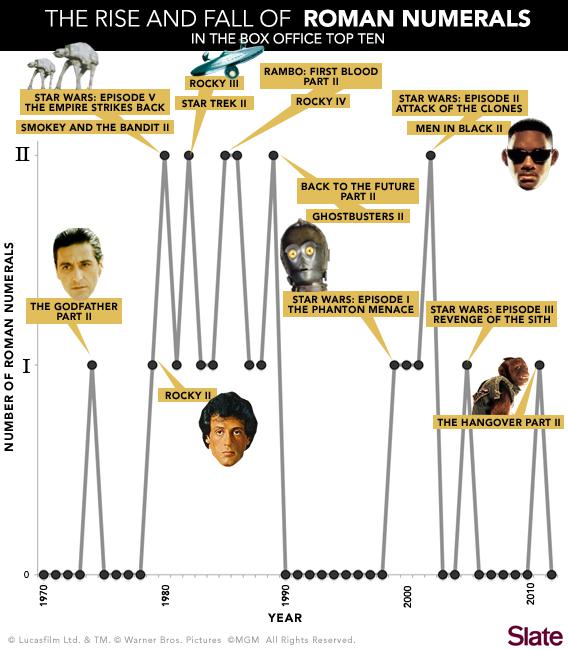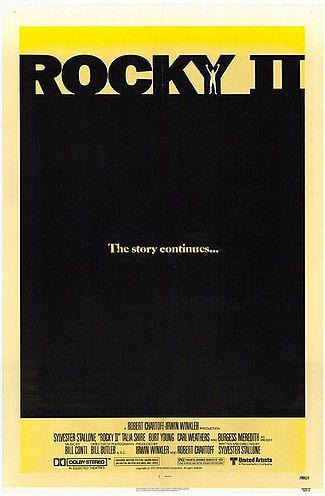Amid all the talk about which ’80s action stars should appear in The Expendables 2—the #1 movie at the box office last weekend—everyone appears to have overlooked something: the numeral. As all ’80s action fans know, the proper numeral system for any Sylvester Stallone actioner is Roman. Those unmanly Arabic numerals just don’t cut it.
Sly himself seems to appreciate proper typography: When fans worried that the Expendables sequel would be downsized to an unmanly PG-13, he took his StalloneZone blog to reassure the people, “Expendables II is an R.” (Note the numeral, which is Mr. Stallone’s.) The Rambo and Rocky star would know: All of his classic ’80s sequels came out in the unbending lines of Roman numerals—from Rocky II (1979) and Rambo: First Blood Part II (1985) to Rambo III (1988) and Rocky V (1990). A generation of American children—or at least Bart Simpson—learned how to read the antiquated numerals from these movies. (In one episode of The Simpsons, Bart finds the Roman numeral for seven by adding Rocky II to Rocky V.)
But that was 17 years ago. These days, youngsters raised on the Spider-Man and Transformers sequels may never learn the classical style. How did the Roman numeral win and then lose Hollywood’s graces?

Original poster for The Godfather Part II.
It began with the greatest sequel of all time, The Godfather Part II. Until the mid-1970s, sequels weren’t usually numbered at all. Instead, they took names like After the Thin Man (1936) and Another Thin Man (1939), or Bride of Frankenstein (1935) and Son of Frankenstein (1939). One of the first sequels was The Fall of a Nation, Thomas F. Dixon’s sequel to the blockbuster The Birth of a Nation. And this continued through the early ’70s. The Planet of the Apes franchise, for instance, used names like Beneath the Planet of the Apes (1970) and Escape from the Planet of the Apes (1971). Even in the rare case that a title was numbered—think of Henry IV Part 2, originally The Second Part of Henry the Fourth—Arabic numerals were used.
The tremendous success of The Godfather Part II, both at the box office and Oscars, would revolutionize Hollywood nomenclature for the next 15 years. There were rumblings of a return to Roman numerals in the lead up to 1974—they were used by the NFL beginning with Super Bowl V in 1971, and by Led Zeppelin starting with Led Zeppelin II in 1969—but after the Godfather sequel Hollywood began to slap a II on just about any hit it could get its hands on. This began with the French Connection II the following May, and continued with movies like Exorcist II in 1977 and Damien: Omen II in 1978. None of these films lived up to the originals at the box office, though, and it wasn’t until Rocky II (1979) and the Star Wars sequels (beginning with Star Wars Episode V: The Empire Strikes Back in 1980) that Roman numerals really took off.
Soon the rule was “When in Hollywood, count as the Romans do.” The slashers joined in, with Halloween II and Friday the 13th Part II in 1981. Psycho even got a sequel, 22 years after the original, called Psycho II (1983). No Arabic numeral would be grand enough for Superman or Star Trek, and so Superman II soared across the screens in 1980, followed by Star Trek II: The Wrath of Khan in 1982.

Chart by Natalie Matthews-Ramo.
Soon the Latin numbers were even spread out across comedies. The teen comedy Porky’s II in 1983 (not to mention The Sting II the same year) was followed by Meatballs Part II and Cannonball Run Part II in 1985. But at first even that wasn’t enough to slow the Roman numeral’s momentum. The Superman and Rocky movies each rolled on into III and IV, while Stallone capitalized on his brand with Rambo: First Blood Part II in 1985. The trend would reach its culmination in 1990, with the return of many of the original Roman numeral releases. These include The Godfather Part III, The Exorcist III, Rocky V, Rambo III, and Back to the Future Part III, along with stragglers like Young Guns II and The NeverEnding Story II.

Original poster for Rocky II.
But the credibility of the Roman numeral—meant to convey something magisterial and historic—finally wore thin with overuse. Most of the 1990 films were box office disappointments, beaten by Arabic titles like Die Hard 2, and by the end of the year the press was noting that Arabics were coming back into vogue. By 1991, Roman numerals were employed almost exclusively for schlocky horror films and comedies (and, increasingly, video games), in a mockery of their original use. The monster Terminator 2 got an Arabic number, while the Roman-styled films were Pet Sematary II (1992), Weekend at Bernie’s II (1993), City Slicker’s II: The Legend of Curly’s Gold (1994), the action-comedy Beverly Hills Cop III (1994), and Major League II (1994). In two decades, the Roman numeral had gone from The Godfather Part II to Father of the Bride: Part II.
And then it nearly disappeared. After dominating the box office throughout the 1980s, Roman numerals wouldn’t return to the domestic box-office top 10 until 1999, the year of Star Wars Episode I. The Star Wars prequels led to a small renaissance in Roman numerals: They were soon vying against Mission: Impossible II (2000), Jurassic Park III (2001), Men in Black II (2002), Blade II (2002), and Bad Boys II (2003) for box office supremacy.
But the nostalgic mood lasted no longer than the Star Wars prequels. Now you’re unlikely to spot a Roman numeral outside of a horror franchise (the Saw films, for example) or a jokey comedy title (the Star Wars-obsessed Clerks II, The Hangover Part II). It was a grave moment for the Roman numeral when even Rocky and Rambo made their triumphant returns without one (2006’s Rocky Balboa, 2008’s Rambo). If The Expendables can’t bring back the Roman numeral—and there are rumors of an Expendables 3—there may not be anyone who can.
